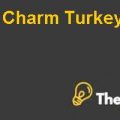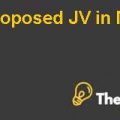The Bourland Companies Case Solution
Quantitative Questions
Question: 4
In this situation, there is a building initially valued at $100 million, and it is financed using a combination of 60% first-position debt, 20% mezzanine debt, and 20% equity. The mezzanine debt participates in 50% of the capital appreciation and has a lower priority compared to the first position debt but a higher priority than the equity portion. If the building's value suddenly drops by 20% to $80 million, we can assess the consequences for all the parties involved. First, calculate the available claims for each party:
- Mezzanine Debt: The mezzanine debt holds a claim of $30 million.
- First Position Debt: The first position debt has a claim of $60 million.
- Equity: The equity investors initially invested $10 million.
Now, let's address the consequences:
Mezzanine Debt
Since the mezzanine debt's claim is subordinate to the first position debt, it is fully covered by the proceeds from the sale, given that the building's value is now $80 million. The mezzanine debt will receive $30 million, fully satisfying its claim.
First Position Debt
The first position lender has a claim of $60 million and will receive priority in the claim over the remaining proceeds from the sale. With a building value of $80 million, the first position debt will receive the entire amount, satisfying its claim.
Equity
From the sale, the equity investors will not receive anything, despite their initial investment of $10 million. The building decreased value and the precedence of both the mezzanine and first-position lenders has left no funds to allocate to the equity investors.
Other Possibilities
Consequently, the mezzanine and first-position lenders will receive their respective claims, while the equity investors will not receive any proceeds from the sale due to the reduced building value and the priority claims of the lenders. In this scenario, the equity has effectively no value, resulting in an ROI of 100% (indicating a complete loss of the initial investment) and an Equity Multiple of 0 (indicating no return on equity investment).
Question: 5
Maximum Loan Amount
Obtaining a loan of $7,865,000 is only feasible under these exact refinancing terms. The calculation takes into account the minimum Debt Service Coverage Ratio of 1.25, the property value, and the maximum Loan-to-Value ratio of 65%. This stringent Debt Service Coverage Ratio is pivotal in determining if the net operating income (NOI) can uphold the essential debt service.
Qualitative Aspect
In a qualitative assessment, when identifying the refinancing offer that provides the highest loan amount, the key factor to consider is the LTV. A higher LTV allows for a larger loan amount because it implies that the lender is willing to finance a greater portion of the property's value. However, it's essential to note that a higher LTV also indicates higher leverage and risk.
Lowering the DSCR requirement can sometimes lead to a larger loan amount since it allows for less income coverage. However, this also increases the risk for both the borrower and the lender, as there is less margin for covering the debt service.
As for identifying the offer with the lowest payment, you would typically look for the longest loan term, the lowest interest rate, and the lowest required DSCR. A longer loan term spreads the repayment over more years, reducing the annual payment amount. A lower interest rate results in lower interest expenses, and a lower DSCR requirement reduces the income necessary to cover the debt service.
Question: 6
IRR based on the Incremental CFs from the Refinancing Decision
The investor in this scenario faces a crucial decision regarding a property with a market cap rate of 9%. They have two main options: selling the property immediately at this cap rate or refinancing it and subsequently selling it at the end of Year 3. To make an informed choice, the investor has thoroughly evaluated the incremental cash flows associated with each option.
The calculations reveal that by choosing to refinance the property and selling it at the end of Year 3, the investor can expect to achieve an Internal Rate of Return (IRR) of 14%. In other words, this decision is projected to yield a 14% return on the investor's capital. In contrast, if they were to sell the property immediately at the 9% cap rate, they would forego this higher return..........
The Bourland Companies Case Solution
This is just a sample partial case solution. Please place the order on the website to order your own originally done case solution.













